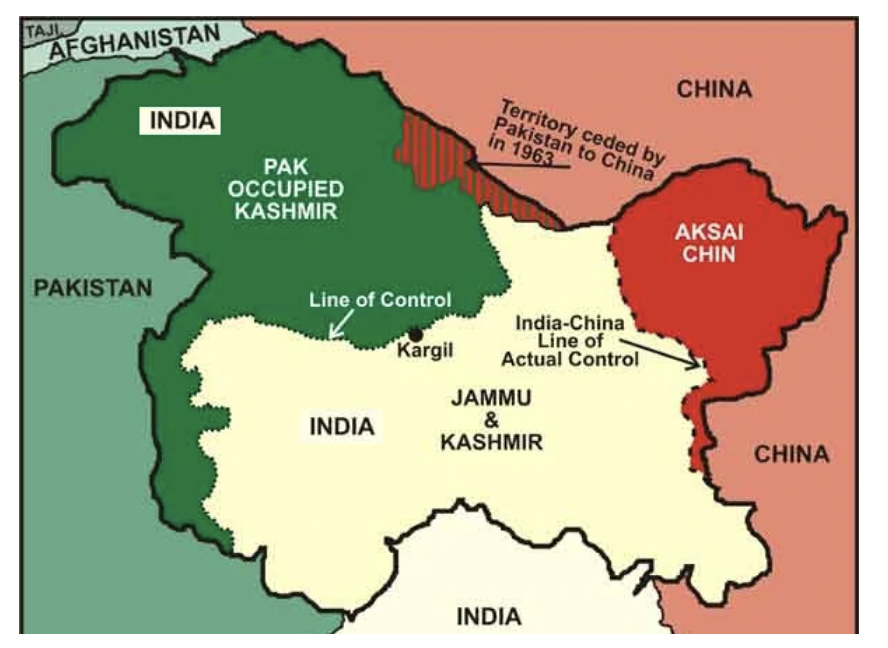GS Paper II
News Excerpt:
The rare admission from the Pakistani government came in Islamabad High Court in the kidnapping case of Kashmiri poet Ahmed Farhad Shah.
More about news:
- Pakistan government admitted in Islamabad High Court that it had no jurisdiction over POK (Pak Occupied Kashmir).
- This rare admission came from the Additional Attorney General of Pakistan. He reasoned that the judgements of Pakistani courts in PoK appear as ‘judgements of foreign courts’.
- Ahmed Farhad Shah is known for his defiant prose and was allegedly abducted from his house on May 14. A day after his alleged abduction, the Kashmiri poet’s wife Urooj Zainab filed a petition and sought her husband’s recovery.

The story behind Pakistan occupied Kashmir (POK):
- Historically, Pakistan-Occupied Kashmir (PoK), once part of the princely state of Jammu and Kashmir, was illegally occupied by Pakistan in 1947. During India's Independence in 1947, the British relinquished their claim over the princely state, offering the choice of joining India, Pakistan, or remaining independent.
- At that time, Maharaja Hari Singh, the ruler of Jammu and Kashmir, opted for an independent dominion status. However, an uprising in 1947 emerged in Poonch due to punitive taxes imposed by Hari Singh on the region's peasantry.
- In October of the same year, thousands of Pashtun tribesmen from the North-West Frontier Province, backed by the Pakistani Army, infiltrated Jammu and Kashmir aiming to free it from the Maharaja's rule.
- Despite attempts by the Maharaja's army to contain the situation, they failed, leading to the insurgents gaining control over much of the Poonch district. They succeeded in capturing Muzaffarabad and Baramulla. Subsequently, the Maharaja sought Indian government assistance.
- The Indian government agreed but on one condition, the Maharaja had to sign an "Instrument of Accession.” The Maharaja signed it and handed over control of defence, external affairs, and communication to the Indian government.
- Indian troops were swiftly dispatched to Srinagar, and a war began between the Indian and Pakistani armies. This resulted in stabilised control over two regions. The area under the influence of Pakistan-backed rebellions was renamed now known as the Pakistan-occupied Kashmir.
Current Issues Associated with POK
- Limited commerce: The economy of POK has been badly damaged by the suspension of commerce between India and Pakistan since 2019. An important source of revenue, exports to India have drastically decreased.
- Dependency on Pakistan: POK is highly dependent on financial support from Pakistan, which leaves it open to the country's own economic issues.
- Underdeveloped Infrastructure: Business development and investment are hampered by inadequate infrastructure, such as transportation networks and energy.
- Emphasis on Security: Funds are frequently redirected to address security issues, which reduces funding for social and economic development initiatives.
- Restricted Work Opportunities: High rates of unemployment, especially for young people.
Key Drivers in POK
- The Taliban Threat:- Over the past few years, the Taliban have seized power in some parts of Pakistan. Few reports hinted at the possibility of Shariat law being imposed in POK; it has already been implemented in Swat in the heartland of Pakistan. The Taliban would attempt to gain strategic depth in this strategically located region.
- Militant Training Camps:- POK has for long provided safe haven to home-grown terrorists of Pakistan – both those operating in Kashmir Valley and those having close links with al‑Qaeda and Taliban. The LeT operates freely in the area of Jamaat ud-Dawa (JuD).
- Sectarian Divide:- The demography in Gilgit Baltistan in POK has changed so much that the Shia, the original inhabitants of the land, have become a minority. Sunnis from Pakistan were given lucrative job offers and other incentives to settle in POK. President Zia intended to shift the demographic balance of POK in favour of Pakistan, primarily a Sunni state, and the orders to this effect were carried out by Pervez Musharraf in the late 1980s.
- China’s Growing Influence:- The Chinese interest in POK dates back to the construction of the Karakoram Highway, the highest road in the world, built at a height of 4665 metres (15,397 feet). The highway has yielded tremendous trading opportunities for both countries. It has also been used extensively to transfer arms and ammunition from China to Pakistan, and fissile nuclear and missile material from China. The highway was opened to the public only in 1986 even though it was completed in 1978 and was inaugurated in 1982.
- Water Resources:- POK is rich in water resources. The Indus and its tributaries render bright opportunities for hydropower generation.
|
Kashmir Dispute
|
Pakistan's Constitution and the Status of PoK
- No Explicit Inclusion: Pakistan's Constitution, in Article 1, defines the country's territory as comprising specific provinces and the federal capital. While it allows for future inclusions, there's no mention of PoK or "Azad Kashmir" (the term Pakistan uses).
- Conditional Accession (Article 257): This article states that PoK will only be part of Pakistan if its people decide to join through a formal process. Essentially, Pakistan's claim rests on the future will of the PoK population.
- Uncertain Status: The absence of a concrete decision by PoK residents leaves the territory in legal limbo. It's technically "foreign land" according to Pakistan's own Constitution.
India's Stance:
- Integral Part: India maintains a firm position that PoK is an inseparable part of its territory. This stance has been recently reiterated by the External Affairs Minister.
- Recent Unrest: Unrest in PoK is seen by India as a potential consequence of the people comparing their situation with the rest of Jammu and Kashmir.
- Longstanding Commitment: India emphasises its commitment, shared by all major political parties, to bring PoK back under its control.
Conclusion:
The status of PoK remains a contentious issue between India and Pakistan. Pakistan's own Constitution doesn't definitively incorporate the territory, while India asserts its historical claim. The future of PoK hinges on a potential decision by its residents and the ongoing political dynamics between the two countries.


